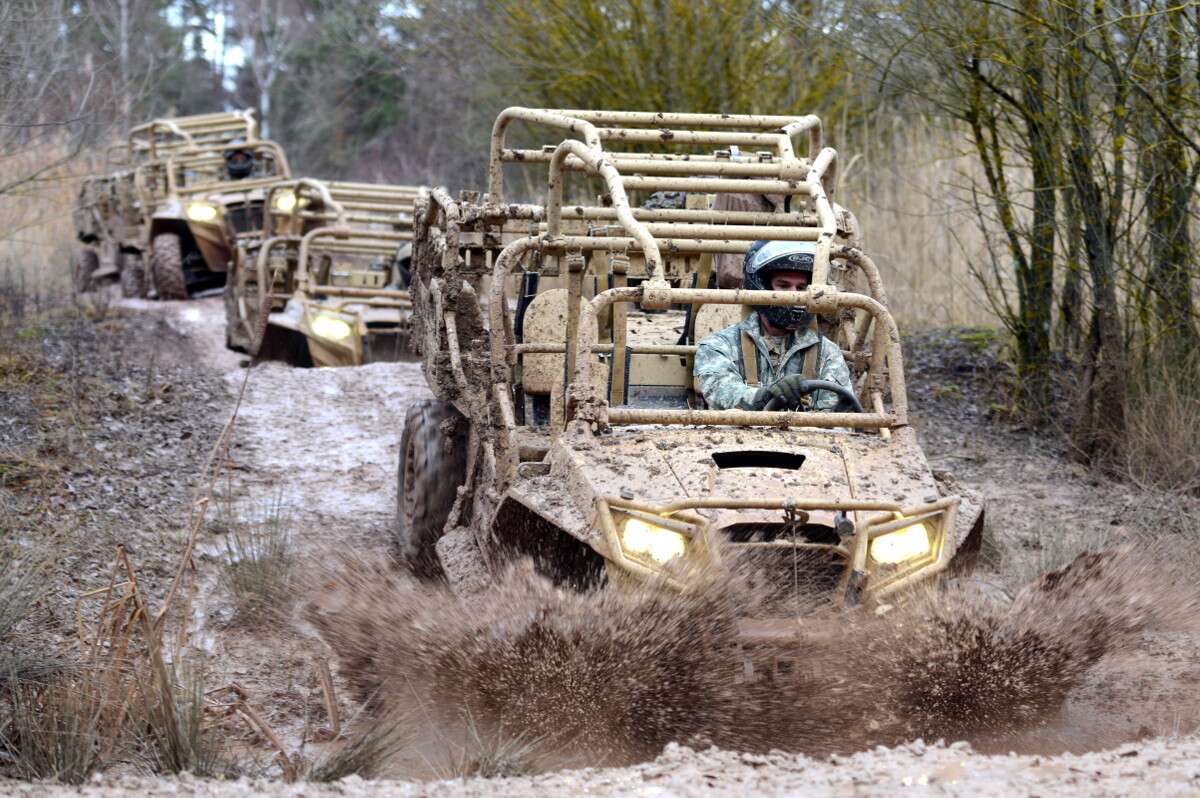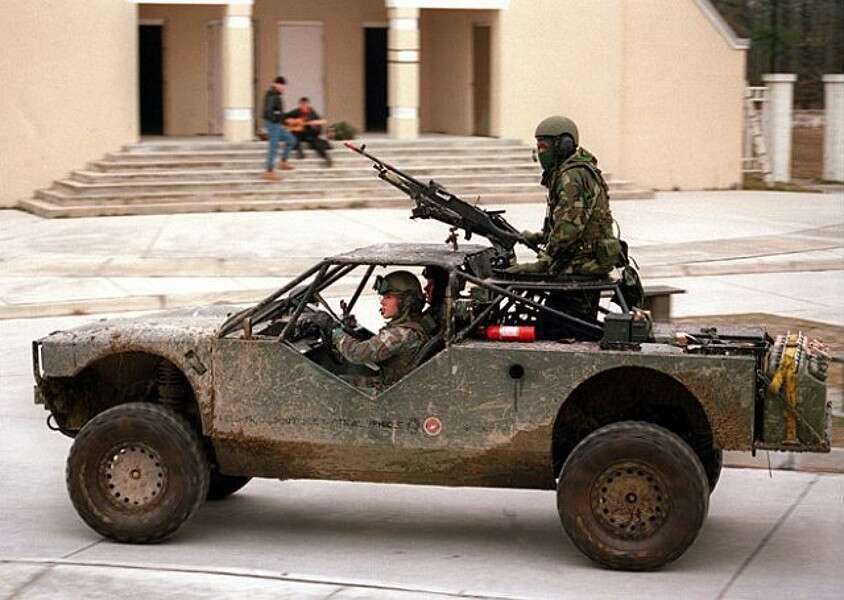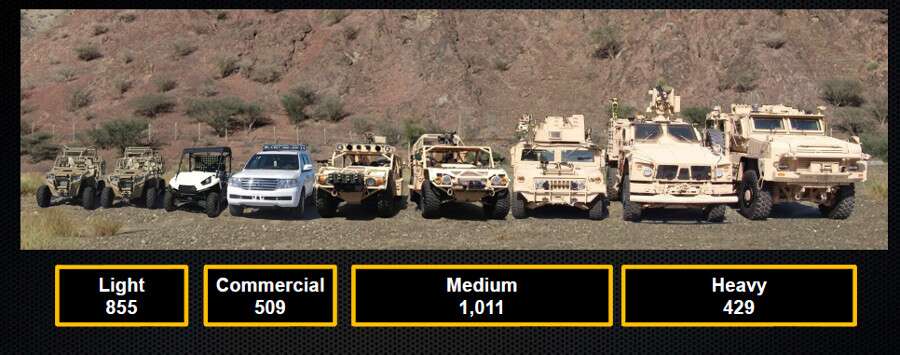U.S. Special Operations Command is looking to find a light tactical vehicle that is more capable than its existing all-terrain vehicles, but can still fit inside a V-22 Osprey tiltrotor in a combat-ready configuration. The new requirements effectively concede that the larger internally-transportable vehicles American special operators have access to at present are not truly capable of performing those missions.
U.S. Marine Corps Lieutenant Colonel Thomas Atkinson gave new details about the effort to develop a new “purpose built” internally-transportable vehicle (ITV) at the National Defense Industry Association’s annual Special Operations Forces Industry Conference earlier in May 2018. Atkinson is presently the program manager in charge of the Family Special Operations Vehicles, or FOSOV, for Special Operation Command’s Program Executive Office (PEO) Special Operations Forces (SOF) Warrior. The FOSOV includes a wide array of different vehicles, including militarized all-terrain vehicles, upgraded civilian trucks, and larger Mine Resistant Ambush Protected (MRAP) types.
“We want something beefier than MRZR with more performance and additional life,” he said. According to the Marine officer, U.S. special operations forces presently rely heavily on Polaris Government and Defense MRZR-2 and MRZR-4 all-terrain vehicles, which it refers to collectively as Light Tactical All Terrain Vehicles (LTATV), for so-called “fly and drive” operations involving the V-22.
This means that the aircraft can land and special operators can drive their vehicles straight off and be ready to go for the mission at hand without needing to reattach any weapons or other components. Lighter all-terrain vehicles and motorcycles also have this capability, but have more limited payload capacity than the MRZRs. These various light vehicles give special operators added mobility after inserting into remote or austere locations where it might not even necessarily be possible to operate more traditional military trucks.
US Army Special Forces soldiers train to drive MRZRs.
The problem is that none of these types of vehicle offer significant mounted firepower or protection for the occupants that those larger, purpose-built vehicles offer. According to Jane’s 360, Lieutenant Colonel Atkinson said the specific goals of the new ITV program were to provide better lethality and survivability over the MRZR, as well as a boost in mobility and range.
“They aren’t being used really … no one will approve any real operation with MRZR,” an unnamed U.S. Marine Corps special operator told Marine Corps Times in January 2018. “We’ve used them for recon in training but not in real life.”
That being said, there is photographic proof that U.S. Army special operators have employed the all-terrain vehicles in combat in Iraq and Syria. In particular, pictures emerged from the campaign to liberate the Iraqi city of Mosul from ISIS terrorists in 2016 showed Special Forces soldiers in MRZRs working closely with Kurdish forces close to the front lines.
Regardless of the differing opinions between the services, finding an acceptable design is easier said than done. For as long as the V-22 program has existed, special operations forces, as well as the Marines in general, have been interested in a combat worthy vehicle that can fit inside the aircraft.
A MillenWorks Helicopter Transportable Tactical Vehicle, which the Marines evaluated in the late 1990s and early 2000s as a possible internally-transportable option for the V-22, as well as the CH-53 series of helicopters.
The Marine Corps ultimately procured a number of variants of a jeep from a company called American Growler, which proved to be costly and controversial. Since at least 2015, the service has been looking for a suitable replacement for those vehicles.
In 2014, Special Operations Command had begun evaluating General Dynamics Land Systems’ Flyer 60 light vehicle as a possible ITV. This design does fit inside an Osprey, but not in a mission-ready form.
In the end, American special operators began receiving a version of the larger Flyer 72, which the U.S. military now calls the M1288 or the Ground Mobility Vehicle 1.1. Though still billed as an ITV, this type is too big for the V-22 and can only squeeze inside larger CH- or MH-47 Chinook or CH-53E helicopters in a truncated configuration.
The video below shows personnel loading Flyers onto V-22s and MH-47 Chinooks, but with many systems removed and stowed beforehand.
https://youtube.com/watch?v=VeN0RTo_V7Y%3Frel%3D0
On top of that, U.S. special operations forces have questioned whether it offers enough firepower and protective features to be truly useful during operations where there is a higher likelihood of direct combat. In January 2018, The War Zone was first to report that Special Operations Command planned to pay defense contractor Military Systems Group more than $3 million for new turrets that could accept a Common Remotely Operated Weapon Station, or CROWS.
This remotely-operated system, which can accept various weapons, such as the .50 caliber M2 machine gun and 40mm Mk 47 automatic grenade launcher, would allow the gunner to remain within the safety of the vehicle’s main cabin when engaging enemy forces. General Dynamics is already offering additional armor suites for the Flyer series and has proposed adding active-protection systems to the vehicles.
A Flyer 72 with one layer of additional armor and the Iron Fist active protection system.
The M1288s will almost certainly be unable to unable to fit inside the V-22 or even larger helicopters with those various features installed, especially the CROWS, which will dramatically increase its overall height. These additions could also have a significant impact on the vehicle’s payload capacity and performance.
We don’t know what Special Operations Command’s exact requirements are for the new vehicle, but these past and existing examples demonstrate the very real difficulties in combining the desired capabilities with a platform that fits inside the V-22, or even larger aircraft. There’s also a cost factor that could come in to play.
MRZRs have a unit cost of less than $40,000. The prototype Flyer 60 in a dedicated ITV configuration that Special Operations Command bought in 2014 had a price tag of nearly $500,000.
A 2015 briefing slide detailing the Flyer-based ITV.
General Dynamics has since stepped up production of the Flyer series and is adding new types, including a multi-purpose version akin to a lightweight pickup truck called the Flyer 72 Tactical Utility Vehicle, so those costs have likely dropped somewhat since then. However, these larger vehicles will never be as inexpensive as an all-terrain vehicle.
According to Jane’s 360, Lieutenant Colonel Atkinson specifically noted that PEO SOF Warrior had limited funds available for the new project at present. And as of 2017, Special Operations Command had more than 850 MRZR-2s and -4s in service.
A breakdown of the FOSOV fleet as of 2017.
Replacing any significant portion of these vehicles could easily become an expensive proposition. But if American special operations forces are increasingly reluctant to use those all-terrain vehicles on actual missions, any cost savings might be a moot point.
We won’t have to wait long to see what defense contractors propose to fill this apparent capability gap. One immediately apparent option might be the development of a lightweight armor suite that fits onto the existing MRZRs. In April 2018, Israeli firm Plasan recently unveiled the Yagu, a variant of the Arctic Cat Wildcat, a similar all-terrain vehicle, with a composite armor package that would seem to be an ideal solution to the desire for more protection, though it’s not clear if that vehicle, or a similar design, would meet the rest of Speical Operations Command’s requirements.
Atkinson says that an evaluation of various vehicles will begin in the third quarter of the 2018 fiscal year – which began in April 2018 and ends in June – and hopes there will be an actual contract award in either 2019 or 2020. Special Operations Command plans to issue a new LTATV contract in the 2021 Fiscal Year, which it could conceivably combine with this new ITV program.
What seems clear is that special operations still have a very clear desire for a combat-ready vehicle that they can drive straight out of an Osprey and that they are far less than pleased with their current options.
Contact the author: [email protected]
Source: Read Full Article





